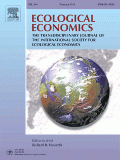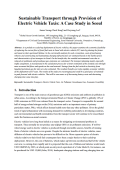

As a prelude to scaled-up deployment of electric vehicles, this paper examines the economic feasibility of replacing the current fleet of fossil fuel taxis in Seoul with electric vehicle (EV) taxis by phasing the former out based on their opertional lifetime. In the cost-benefit analysis for such a transition, costs of purchasing vehicles and constructing and maintaining charging infrastructure are estimated based on the market prices and characteristics of taxi transport in Seoul. On the benefit side, the avoided environmental costs due to reduced air pollutants and greenhouse gas emissions are calculated. The transport planning model, especially traffic assignment, is incorporated in the calculation process for a better estimation of the avoided costs through more accurate link flows and speeds on the road network. Savings from the fuel switch to electricity from liquefied petroleum gas for taxis are also estimated. The resultant benefit-cost ratio signifies economic viability of the deployment of EV taxis. The results of the study are encouraging and could be a good piece of rationale to push forward with electric vehicles.

Effective flood risk management is critical to protect people and their livelihoods from flooding and to limit future losses. Nature-based measures and their ability to address flood risk are receiving increasing attention. Until recently, most flood risk management involved conventional engineering measures. These measures are sometimes referred to as “hard” engineering or “gray” infrastructure. Examples include building embankments, dams, levees, and channels to control flooding. Recently the concept of “nature-based solutions”, “ecosystem-base adaptation”, “eco-DRR” or “green infrastructure” has emerged as a good alternative or complement to traditional gray approaches. Nature-based solutions make use of natural processes and ecosystem services for functional purposes, such as decreasing flood risk or improving water quality. The objective of this document is to present five principles and implementation guidance for planning, such as evaluation, design, and implementation of nature-based solutions for flood risk management as an alternative to or complementary to conventional engineering measures.


The Global Cleantech Innovation Index (GCII) programme investigates where, relative to GDP, entrepreneurial clean technology companies are most likely to emerge from over the next 10 years – and why. Drawing on a wide range of factors and sources, the study "The Global Cleantech Innovation Index 2017: Which countries look set to produce the next generation of start-ups?" seeks to answer the same question as the 2012 and 2014 GCII reports, namely: which countries currently have the greatest potential to produce entrepreneurial cleantech start-up companies that will commercialize clean technology innovations over the next 10 years? Based on the data contributing to 15 indicators of creation, commercialisation and growth of cleantech start-ups in 40 countries, the study identifies different key trends and shows which countries are falling ahead and below the curve for cleantech innovation.
